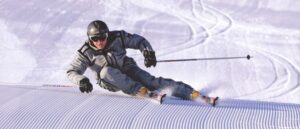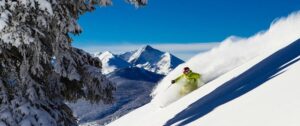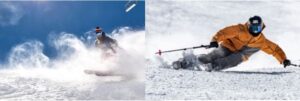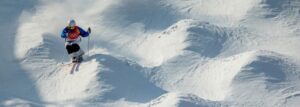A Skis’ Width Says a Lot
by Mike Whitaker
If you want to know what a ski is designed to do, look at its waist width first. This midsection measurement is one of the more important considerations when choosing a ski. Waist width tells the story of what a skis’ intended use is. It may be a full floater for deeper days. It may be a screaming carver for slicing up the hard packed and corduroy. It may be an easy rider for beginners. Or it may be just the right ski you’re looking for?
The general rule and the place to start focusing your horizon is 90mm and below for packed conditions and 90mm and above as the snow gets deeper. Skis with narrow waists, generally 90mm or lower, make quicker turns and are better suited for carving on hardpack. Skis with larger waist, generally 90mm and above have more float, provide better stability, and easier turns when you head off the groomers.
The next determiner in the search for the perfect width is what type of terrain will the ski be used on? If you’re headed out for a heli trip then 110mm plus underfoot. If you’re riding on and off-piste inbounds in places subject to big dumps like Utah, go 100mm to 110mm. If you’re seeking a do-it-all one ski quiver, look no farther than 90mm to 100mm for the West and mid 70s to mid 80s for the East.
An East – West consideration is a good benchmark. Most everyone understands hard snow in the East, soft in the West. This equates to going to the wider side of the intended use for the West.
Casual recreational skiers, us socialites who seek the apres ski scene and enjoy the pristine corduroy of Deer Valley, we head for mid 70s to low 80mm range regardless of East/West orientation. Racers and tip-em and rip-em junkies will be in the mid 60s to low 70s underfoot. So will serious bumpers who will dip into the low 60mm waists. Keep in mind that race oriented skis and performance mogulers are speciality considerations.
Ability is another important width factor. Beginners through advancing intermediates benefit from a narrower ski. Narrow sided skis are easier to control, advance learning better, and just more enjoyable for this target group. They are more nimble, more responsive, and take less effort to initiate a turn. And it’s easier to learn and perfect carving on a narrow ski.
Narrow Skis – Frontside Carvers, Racers, and Progression Skis
For beginners to intermediates, these skis hover in the upper 70mm waists and are soft to bend. They are lightweight, easy to turn, and forgiving of mistakes.
On the opposite side of the spectrum are race skis. These skis are in the 60mm waist range and are designed for one purpose: to rip. They are powerful, unforgiving, and fast. Racers are finely tuned athletes with legs of steel that can bend and control these merciless rockets.
In the middle of the narrow group lie skis that linger in the mid 70mm to mid/upper 80mm waists. These boards encompass a wide range of abilities from advancing intermediates to superheroes. The narrower they are the quicker they are edge to edge and the tighter they turn. The stiffer they are the faster they go and the more unforgiving. They begin to offer some float as they become wider, better managing the occasional venture off-piste. They are not, however, built for powder days and you’ll be much happier opting for something wider.
Wide Skis – Powder Performers
At about 104mm and up in the waist, these boards excel in the soft and deep. They’ll handle chop, mashed, and crud too. These skis are maneuverable and are becoming easier to ride and more versatile, opening up the back bowls and side gates to even intermediates. Many sport midsection camber and hold a respectable edge on harder conditions but not without some extra work and technique. They’re highly focused towards the soft, thus they are not generally considered an everyday rider. However, if you haunt places like Alta, Kicking Horse, or a heli camp, these are everyday riders.
Mid Fats – The Boards In-Between
These are skis with waists from the mid 80mm to 100mm or so. They are designed to tackle everything fairly well and that they do. From pristine corduroy, to powder, and everything in-between these are the everyday, all-mountain go-to sticks. They’ll carve with confidence. Float a foot or better of fresh. They wield chop, crud, and even bumps.
Those that spend most their time on-piste, occasionally venturing off, will look towards the narrow side of this group. This also holds for those who need Eastern ice performance and those who are progressing. Soft snow seekers will look to the wider side. They’ll benefit from the added float and powder stability.
Whether you’re looking for an East Coast performer or a Western States slayer, skis in this group make a greater part of the mountain more accessible for everyone.
Contrary to what many influencers say, the best mogul performers are narrow. World Cup athletes ride skis near 60mm underfoot. Us mortals also benefit from a narrow ski when it comes to a mogul ride. As skis have become more versatile, boards upwards of 90mm have become very manageable in the bumps, even fun. Still, go narrow if bumping is your thing. Look to the 60mm waist range if you’re a zipperline ninja. Go to the mid 70mm/80mm range for a more human ride and more versatility out of the bumps.
Bumps are fun but a lot of people struggle here. Usually, it’s the wrong ski – skis that are too wide, too long, too stiff. Stick to skis on the softer side with an early rise tip rocker. They should be about nose high and not too much sidecut. And for heaven’s sake, run the other way when someone recommends a mogul ride that’s 95mm in the waist.








